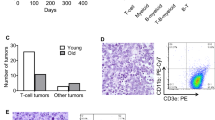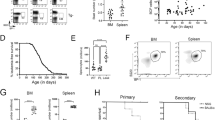Abstract
Breast-cancer-associated gene 1 (BRCA1) is highly expressed in thymus and spleen. In this paper, we have studied lymphocyte development and tumorigenesis in mice carrying mutations in Brca1 and p53. We show that the deletion of Brca1 exon 11 (Brca1-Δ11), which disrupts the full-length isoform, but not the short isoform of Brca1, does not interfere with lymphocyte development. This is true irrespective of p53 status, that is, whether it is wild type, heterozygous or homozygous for a null mutation. These data suggest that the expression of Brca1 short isoform alone is enough to maintain normal development of lymphocytes. However, it cannot suppress tumorigenesis as about 30% of Brca1Δ11/Δ11p53+/− mice develop thymic lymphoma between 3 and 7 months of age. We demonstrate that p53 plays an essential role in Brca1-associated lymphoma, as all the tumors from Brca1Δ11/Δ11p53+/− mice exhibit LOH of p53 and Brca1Δ11/Δ11p53−/− mice exhibited accelerated tumorigenesis. We further demonstrate that the Brca1-Δ11 deficiency does not affect thymocyte proliferation; however, it increases genetic instability and triggers γ-irradiation-induced apoptosis. The loss of p53 attenuates apoptosis and allows accumulation of further mutations in Brca1-Δ11 thymocytes, eventually leading to thymic lymphoma formation.
This is a preview of subscription content, access via your institution
Access options
Subscribe to this journal
Receive 50 print issues and online access
$259.00 per year
only $5.18 per issue
Buy this article
- Purchase on SpringerLink
- Instant access to full article PDF
Prices may be subject to local taxes which are calculated during checkout






Similar content being viewed by others
References
Abbott DW, Thompson ME, Robinson-Benion C, Tomlinson G, Jensen RA and Holt JT . (1999). J. Biol. Chem., 274, 18808–18812.
Bachelier R, Dalla Venezia N, Mazoyer S, Frappart L, Lenoir GM and Vincent A . (2000). Int. J. Cancer, 88, 519–524.
Baldeyron C, Jacquemin E, Smith J, Jacquemont C, De Oliveira I, Gad S, Feunteun J, Stoppa-Lyonnet D and Papadopoulo D . (2002). Oncogene, 21, 1401–1410.
Barlow C, Hirotsune S, Paylor R, Liyanage M, Eckhaus M, Collins F, Shiloh Y, Crawley JN, Ried T, Tagle D and Wynshaw-Boris A . (1996). Cell, 86, 159–171.
Bennett LM, Haugen-Strano A, Cochran C, Brownlee HA, Fiedorek Jr FT and Wiseman RW . (1995). Genomics, 29, 576–581.
Bernstein C, Bernstein H, Payne CM and Garewal H . (2002). Mutat. Res., 511, 145–178.
Bochar DA, Wang L, Beniya H, Kinev A, Xue Y, Lane WS, Wang W, Kashanchi F and Shiekhattar R . (2000). Cell, 102, 257–265.
Bork P, Hofmann K, Bucher P, Neuwald AF, Altschul SF and Koonin EV . (1997). FASEB J., 11, 68–76
Brodie SG and Deng CX . (2001). Trends Genet., 17, S18–S22.
Brodie SG, Xu X, Li C, Kuo A, Leder P and Deng CX . (2001a). Oncogene, 20, 1445–1454.
Brodie SG, Xu X, Qiao W, Li WM, Cao L and Deng CX . (2001b). Oncogene, 20, 7514–7523.
Callebaut I and Mornon JP . (1997). FEBS Lett., 400, 25–30.
Chai YL, Cui J, Shao N, Shyam E, Reddy P and Rao VN . (1999). Oncogene, 18, 263–268.
Chen Y, Farmer AA, Chen CF, Jones DC, Chen PL and Lee WH . (1996). Cancer Res., 56, 3168–3172.
Chen JJ, Silver D, Cantor S, Livingston DM and Scully R . (1999). Cancer Res., 59, 1752s–1756s.
Connor F, Bertwistle D, Mee PJ, Ross GM, Swift S, Grigorieva E, Tybulewicz VL and Ashworth A . (1997). Nat. Genet., 17, 423–430.
Cortez D, Wang Y, Qin J and Elledge SJ . (1999). Science, 286, 1162–1166.
Deng CX and Brodie SG . (2000). Bioessays 22, 728–737.
Donehower LA, Harvey M, Slagle BL, McArthur MJ, Montgomery Jr CA, Butel JS and Bradley A . (1992). Nature, 356, 215–221.
Easton DF, Ford D and Bishop DT . (1995). Am. J. Hum. Genet., 56, 265–271.
Edelmann W, Yang K, Umar A, Heyer J, Lau K, Fan K, Liedtke W, Cohen PE, Kane MF, Lipford JR, Yu N, Crouse GF, Pollard JW, Kunkel T, Lipkin M, Kolodner R and Kucherlapati R . (1997). Cell, 91, 467–477.
Elliott B and Jasin M . (2002). Cell Mol. Life Sci., 59, 373–385.
Ford D, Easton DF, Stratton M, Narod S, Goldgar D, Devilee P, Bishop DT, Weber B, Lenoir G, Chang-Claude J, Sobol H, Teare MD, Struewing J, Arason A, Scherneck S, Peto J, Rebbeck TR, Tonin P, Neuhausen S, Barkardottir R, Eyfjord J, Lynch H, Ponder BA, Gayther SA, Birch JM, Lindblom A, Stoppa-Lyonnet D, Bignon Y, Borg A, Hamann U, Haites N, Scott RJ, Maugard CM, Vasen H, Seitz S, Cannon-Albright LA, Schofield A, Zelada-Hedman M and the Breast Cancer Linkage Consortium. (1998). Am. J. Hum. Genet., 62, 676–689.
Garcia-Higuera I, Taniguchi T, Ganesan S, Meyn MS, Timmers C, Hejna J, Grompe M and D'Andrea AD . (2001). Mol. Cell., 7, 249–262.
Gatei M, Scott SP, Filippovitch I, Soronika N, Lavin MF, Weber B and Khanna KK . (2000). Cancer. Res., 60, 3299–3304.
Gatei M, Zhou BB, Hobson K, Scott S, Young D and Khanna KK . (2001). J. Biol. Chem., 276, 17276–17280.
Gowen LC, Avrutskaya AV, Latour AM, Koller BH and Leadon SA . (1998). Science, 281, 1009–1012.
Gretzula JC, Hevia O and Weber PJ . (1987). J. Am. Acad. Dermatol., 17, 479–488.
Hakem R, de la Pompa JL, Elia A, Potter J and Mak TW . (1997). Nat. Genet., 16, 298–302.
Hakem R, de la Pompa JL, Sirard C, Mo R, Woo M, Hakem A, Wakeham A, Potter J, Reitmair A, Billia F, Firpo E, Hui CC, Roberts J, Rossant J and Mak TW . (1996). Cell, 85, 1009–1023.
Hartman AR and Ford JM . (2002). Nat. Genet., 32, 180–184.
Huang J and Dynan WS . (2002). Nucleic Acids Res., 30, 667–674.
Huber LJ, Yang TW, Sarkisian CJ, Master SR, Deng CX and Chodosh LA . (2001). Mol. Cell. Biol., 21, 4005–4015.
Jacks T, Remington L, Williams BO, Schmitt EM, Halachmi S, Bronson RT and Weinberg RA . (1994). Curr. Biol., 4, 1–7.
Khanna KK and Jackson SP . (2001). Nat. Genet., 27, 247–254.
Kuschel B, Gayther SA, Easton DF, Ponder BA and Pharoah PD . (2001). Genes Chromosomes Cancer, 31, 96–98.
Lane TF, Deng C, Elson A, Lyu MS, Kozak CA and Leder P . (1995). Genes Dev., 9, 2712–2722.
Lee JS, Collins KM, Brown AL, Lee CH and Chung JH . (2000). Nature, 404, 201–204.
Liu CY, Flesken-Nikitin A, Li S, Zeng Y and Lee WH . (1996). Genes Dev., 10, 1835–1843.
Lu M and Arrick BA . (2000). Oncogene, 19, 6351–6360.
Ludwig T, Chapman DL, Papaioannou VE and Efstratiadis A . (1997). Genes Dev., 11, 1226–1241.
Ludwig T, Fisher P, Ganesan S and Efstratiadis A . (2001). Genes Dev., 15, 1188–1193.
Luo G, Santoro IM, McDaniel LD, Nishijima I, Mills M, Youssoufian H, Vogel H, Schultz RA and Bradley A . (2000). Nat. Genet., 26, 424–429.
Mak TW, Hakem A, McPherson JP, Shehabeldin A, Zablocki E, Migon E, Duncan GS, Bouchard D, Wakeham A, Cheung A, Karaskova J, Sarosi I, Squire J, Marth J and Hakem R . (2000). Nat. Immunol., 1, 77–82.
Marquis ST, Rajan JV, Wynshaw-Boris A, Xu J, Yin GY, Abel KJ, Weber BL and Chodosh LA . (1995). Nat. Genet., 11, 17–26.
Meza JE, Brzovic PS, King MC and Klevit RE . (1999). J. Biol. Chem., 274, 5659–5665.
Miki Y, Swensen J, Shattuck-Eidens D, Futreal PA, Harshman K, Tavtigian S, Liu Q, Cochran C, Bennett LM, Ding W, Bell R, Rosenthal J, Hussey C, Tran T, McClure M, Frye C, Hattier T, Phelps R, Haugen-Strano A, Katcher H, Yakumo K, Gholami Z, Shaffer D, Stone S, Bayer S, Wray C, Bogden R, Dayananth P, Ward J, Tonin P, Narod S, Bristow PK, Norris FH, Helvering L, Morrison P, Rosteck P, Lai M, Barrett JC, Lewis C, Neuhausen S, Cannon-Albright L, Goldgar D, Wiseman R, Kamb A and Skolnick MH . (1994). Science, 266, 66–71.
Moore JK and Haber JE . (1996). Mol. Cell Biol., 16, 2164–2173.
Moynahan ME, Chiu JW, Koller BH and Jasin M . (1999). Mol. Cell, 4, 511–518.
Moynahan ME, Cui TY and Jasin M . (2001). Cancer Res., 61, 4842–4850.
Scully R, Chen J, Plug A, Xiao Y, Weaver D, Feunteun J, Ashley T and Livingston DM . (1997). Cell, 88, 265–275.
Sharan SK, Wims M and Bradley A . (1995). Hum. Mol. Genet., 4, 2275–2278.
Shen SX, Weaver Z, Xu X, Li C, Weinstein W, Guan XY, Ried T and Deng CX . (1998). Oncogene, 17, 3115–3124.
Snouwaert JN, Gowen LC, Latour AM, Mohn AR, Xiao A, DiBiase L and Koller BH . (1999). Oncogene, 18, 7900–7907.
Thakur S, Zhang HB, Peng Y, Le H, Carroll B, Ward T, Yao J, Farid LM, Couch FJ, Wilson RB and Weber BL . (1997). Mol. Cell Biol., 17, 444–452.
Thompson LH and Schild D . (2001). Mutat Res., 477, 131–153.
Tibbetts RS, Cortez D, Brumbaugh KM, Scully R, Livingston D, Elledge SJ and Abraham RT . (2000). Genes Dev., 14, 2989–3002.
Venkitaraman AR . (2002). Cell, 108, 171–182.
Wang Q, Zhang H, Guerrette S, Chen J, Mazurek A, Wilson T, Slupianek A, Skorski T, Fishel R and Greene MI . (2001). Oncogene, 20, 4640–4649.
Wilson CA, Payton MN, Elliott GS, Buaas FW, Cajulis EE, Grosshans D, Ramos L, Reese DM, Slamon DJ and Calzone FJ . (1997). Oncogene, 14, 1–16.
Xu X, Qiao W, Linke SP, Cao L, Li WM, Furth PA, Harris CC and Deng CX . (2001). Nat. Genet., 28, 266–271.
Xu X, Wagner KU, Larson D, Weaver Z, Li C, Ried T, Hennighausen L, Wynshaw-Boris A and Deng CX . (1999a). Nat. Genet., 22, 37–43.
Xu X, Weaver Z, Linke SP, Li C, Gotay J, Wang XW, Harris CC, Ried T and Deng CX . (1999b). Mol. Cell, 3, 389–395.
Zhong Q, Boyer TG, Chen PL and Lee WH . (2002a). Cancer Res., 62, 3966–3970.
Zhong Q, Chen CF, Chen PL and Lee WH . (2002b). J. Biol. Chem., 277, 28641–28647.
Zhong Q, Chen CF, Li S, Chen Y, Wang CC, Xiao J, Chen PL, Sharp ZD and Lee WH . (1999). Science, 285, 747–750.
Acknowledgements
We thank Steve Linke for help with the FACS analysis, Wenhui Qiao for genotype and Robert Cardiff for immunohistochemical staining.
Author information
Authors and Affiliations
Corresponding author
Rights and permissions
About this article
Cite this article
Bachelier, R., Xu, X., Wang, X. et al. Normal lymphocyte development and thymic lymphoma formation in Brca1 exon-11-deficient mice. Oncogene 22, 528–537 (2003). https://doi.org/10.1038/sj.onc.1206208
Received:
Revised:
Accepted:
Published:
Issue Date:
DOI: https://doi.org/10.1038/sj.onc.1206208



